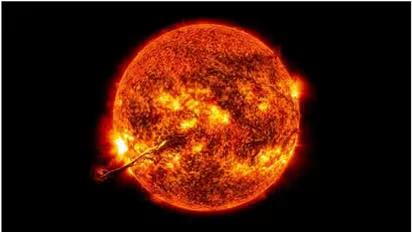Sun to reach 'solar maximum' in 2025, sparks fears of potential 'Internet apocalypse'

Synopsis
Explore the renewed interest in solar cycles and the potential impact of solar storms on global communications, as concerns about the internet's vulnerability gain traction, and experts warn of possible disruptions and economic consequences.
There is growing interest in the solar cycles of the Sun and the potential impact of solar storms, which have the capacity to disrupt global communications. The Washington Post reports that the Sun is expected to reach a period of heightened activity called "solar maximum" in 2025, raising concerns about the readiness of today's digital world to withstand such events. This has led to discussions and misinformation on social media, with terms like "internet apocalypse" capturing attention. While NASA has not commented on the possibility of the 2025 solar storm causing the end of the internet, the Post highlights that these concerns are not entirely fictional.
The article references historical events such as the Carrington Event in 1859, which caused telegraph lines to spark and led to operator electrocutions, as well as the 1989 solar storm that resulted in a power grid failure in Quebec.
The impact of a strong solar storm on our interconnected world could cause widespread internet outages, potentially affecting large-scale infrastructure like undersea communication cables and disrupting long-distance connectivity.
Experts, such as Sangeetha Abdu Jyothi, a computer science professor at the University of California, Irvine, highlight that we have not experienced extreme solar storm events and lack sufficient knowledge of how our infrastructure would respond to them.
"We've never experienced one of the extreme case events, and we don't know how our infrastructure would respond to it. Our failure testing doesn't even include such scenarios," Sangeetha Abdu Jyothi, a computer science professor at University of California at Irvine, told the Post.
Her paper 'Solar Superstorms: Planning for an Internet Apocalypse' played a key role in popularising the term. Jyothi said that a severe solar storm is likely to affect large-scale infrastructure such as undersea communication cables that could interrupt long-distance connectivity.
The article emphasises that the potential consequences of internet outages lasting for months are significant, with the US alone estimated to face an economic impact of over $11 billion for just one day of lost connectivity.
On July 4, as the US celebrated its Independence Day, the Sun held its own firework display. A recent video shared by space weather physicist Tamitha Skov captured solar storms, known as coronal mass ejections (CMEs), observed by NASA's Solar and Heliospheric Observatory (SOHO), serving as a reminder of the Sun's powerful influence and the need to prepare for possible disruptions.
Check the Breaking News Today and Latest News from across India and around the world. Stay updated with the latest World News and global developments from politics to economy and current affairs. Get in-depth coverage of China News, Europe News, Pakistan News, and South Asia News, along with top headlines from the UK and US. Follow expert analysis, international trends, and breaking updates from around the globe. Download the Asianet News Official App from the Android Play Store and iPhone App Store for accurate and timely news updates anytime, anywhere.